This post may contain affiliate links. Please read our disclosure policy.
Elevate your steamed buns game by adding tangzhong or yudane to the recipe. The steamed buns stay soft for days .

If you want steamed buns that remain soft and fluffy for days, I highly recommend using tangzhong. It’s an extra small step, but it’s so worth it. I told my husband that it’s hard to make bread or baozi without using tangzhong these days. I’m so used to the softness that lingers for days. It’s so pillowy soft and simply amazing.
Why add tangzhong or yudane?
When incorporated into steamed bun dough, tangzhong or yudane provides numerous benefits that set these buns apart from their traditional counterparts. Let’s take a closer look at the magic it brings to the table:
1. Enhanced Softness: It locks in moisture, producing a soft, tender crumb. The buns practically melt in your mouth, creating a delightful eating experience.
2. Prolonged Freshness: Steamed buns stay fresh for a longer period. The moisture-retaining properties of the roux prevent the buns from drying out, allowing you to enjoy them even hours after they’re steamed. If stored properly at room temperature, they stay soft for days.
Difference between tangzhong and yudane
Tangzhong is an adaptation of the Japanese technique that involves creating a gel-like mixture by cooking flour and liquid (usually water or milk) together and they are cooked until it reaches 65 C/149 F. Tangzhong is usually prepared using flour to water/milk ratio of 1:5. Yudane is a technique commonly used in Asian bread baking, particularly in Japan. It involves mixing a portion of the flour with boiling water to create a dough-like paste. The yudane mixture is then rested for at least 4 hours or best overnight before incorporating it into the bread dough. Yudane is usually prepared with a ratio of 1:1 or sometimes 1:2
The purpose of both is to increase the moisture content in the dough, resulting in a softer and moister final product.
Which one to use?
Both tangzhong and yudane can yield excellent results in terms of softness and moisture in the bread. The choice between the two techniques often depends on personal preference, regional influences, and the specific recipe being used. Experimenting with both methods can lead to discovering the one that suits your taste and desired bread texture best. I personally like tangzhong better. I feel like the bread/buns are much softer.
Ingredients and substitutions
1. All-purpose flour
I use unbleached all-purpose flour so the color of my steamed buns isn’t as white, but this doesn’t affect the taste of the steamed buns. If you use bleached all-purpose flour, you may get whiter steamed buns and finer in texture. Unbleached flour is more natural and that’s what I usually stock at home
2. Cake flour
Cake flour is very low in gluten and gives the steamed buns a very fluffy light texture. It won’t be cake-like, because we mix it with all-purpose flour to balance the texture between bread and cake
3. Instant yeast
I highly recommend using instant yeast for convenience and also use yeast with high sugar tolerance such as this SAF gold medal yeast. It works wonderfully
4. Baking powder
I recently started to add baking powder to my steamed buns recipe. It does help to make the buns have even fluffier texture. You can skip if you don’t want to use
5. Milk
I recommend using whole milk because it gives a richer taste and the fat keeps the steamed buns moist and fluffy. I have made steamed buns with 2% milk too and they turn out good too
6. Sugar
I use granulated sugar. You can use caster sugar. You can decrease the amount of sugar to suit your needs, but I won’t recommend omitting it altogether. Sugar also contributes to the moistness of the end product
7. Salt
Salt enhances the flavor of the steamed buns. I use fine sea salt
8. Oil
I use neutral-tasting oil such as avocado oil, canola oil, grapeseeds oil, etc

Soft Fluffy Steamed Buns / Baozi with Tangzhong/Yudane
Ingredients
If using tangzhong:
- 30 gr all-purpose flour
- 150 gr milk
Dough with tangzhong:
- 150 gr all-purpose flour plus more for dusting
- 180 gr cake flour
- ½ tsp salt
- 4 gr instant yeast
- 1 tsp baking powder
- 50 gr sugar
- 20 g oil
- 60 g whole milk start with this amount
If using yudane:
- 75 g all-purpose flour
- 75 g hot boiling water
Dough with yudane:
- 105 g all-purpose flour
- 180 g cake flour
- 4 g instant yeast
- ½ tsp salt
- 100 g whole milk
- 50 g sugar
- 20 g oil
Instructions
If using tangzhong:
- Place milk and the flour in a small saucepan. Whisk until there is no more lumps. Cook this mixture over low-medium heat until it reaches 65 C (149 F). Remove from the heat and cover with a plastic wrap, touching the tangzhong so the skin won't form. I highly suggest using this the next day instead of using it on the same day. Store this in the fridge
If using yudane:
- Measure out 75 gr all-purpose flour in a heat-proof bowl. Place this on top of a kitchen scale. Bring water to a boil. I usually boil 15-20 grams extra than what I need to account for evaporation during boiling. When water comes to a boil, don’t turn it off yet, let it boil for another minute or two to make sure it reaches boiling temperature. Use a thermometer if you have one. I make sure it’s at least 212 F/100 C
- Carefully but quickly pour the amount of boiling water you need into the flour and stir with a sturdy spatula until all the flour is hydrated by the hot boiling water. You will get a sticky dough
- Let it cool down to about 122F/50 C. Wrap it with a cling wrap that I lightly sprayed with non-stick spray and let it sit on the counter if you will be using it in 4 hours later or in the fridge for the next day. They can be kept in the fridge for up to 3 days. The longer you rest the yudane, the better the quality of your bread
Prepare the dough:
- Place the flour, instant yeast, sugar, salt, baking powder, oil in a mixing bowl of a stand mixer and stir to combine. Add tangzhong paste or yudane to the dough
- Attach the dough hook to the stand mixer. Turn on the mixer at the lowest speed to prevent the flour from flying all over the place. Knead at low speed (speed 2 on KA) for 3-4 minutes or until the dough roughly come together. If the dough feels dry, add milk, one teaspoon at a time. The dough needs to feel soft. You can increase the speed to speed 4 and knead until the dough clears the side of the bowl, feel smooth and soft, about 3-4 minutes (depending on your machine too).
- If the dough feels stiff, don't be afraid to add more milk. Soft dough is one of the keys to getting soft and fluffy steamed buns. You don't need to develop a window pane here but the dough needs to be soft and smooth
Shaping:
- Divide the dough into 8-10 equal portions. To make plain buns without filling, flatten and gather the edge to round them up into dough balls. Roll the dough into a smooth round ball in between the palm of your hand or as I did in the video. REALLY make sure the dough is smooth.
- If you want to add a filling, flatten the dough with your palm and then use a rolling pin to roll it out to form a circle about 4-5 inches, with a slightly thicker middle part. This is to support the weight of the filling. Don't roll the dough too thin. If you roll the dough too thin, the filling might make the steamed buns "wrinkle" later when you steam. Place the filling at the center and then gather the sides to enclose the bun and pinch to seal. Flip the bun so the seam side is down now
- Cup the dough with both palms and move the dough in a circular motion to shape it taller. This part is important so your steamed buns come out tall instead of spreading to the side after steaming
- Place on a piece of parchment paper. Lightly dab the surface of the bun with some milk using your finger to smooth the surface. You can also mist with some water using a spray bottle. Loosely cover with clean kitchen towel to prevent drying. Work with another dough and do the same. Proceed to proofing after that
Proofing:
- Let the dough rise at room temperature or at a warm place. If it's winter where you are, you can use your oven "bread proof" function to let them proof in there, or simply turn on your oven to the lowest temperature and then turn off and after 15 minutes, place the shaped buns in there to let them proof. They won't necessarily double in size, but at least puff up to about 50% of the original size. This may take about 1 hour or longer at a warm temperature. Don't go by the time however. Observe the dough instead!
- How do you know if your buns have proofed ? They will be about 50% bigger than their original size AND when you lift them up, they should feel significantly lighter. If not, let them proof a bit longer. They may not visually look bigger. Use a finger test too. When you gently push on the dough, it will leave an indentation but it will spring back slowly. This dough is perfectly proofed. If it springs back right away, it needs to be proofed a bit longer. If it never springs back, then you have over-proofed the dough. Loosely cover them with plastic wrap and put the over-proofed buns in the fridge to slow down the proofing while waiting for the steamer
- An under proofed buns will be very dense and have bumpy surface after steaming. An over proofed buns may widen to the side and much flatter, but they shouldn't be dense and heavy. So, overproof may still be a bit "safer" compared to the buns not sufficiently proofed. Ideally, we want it to be perfectly proofed of course
Steaming:
- Most likely your steamer won't be able to accommodate steaming all buns at one go. You may need to steam in 2-3 batches, which means, the rest of the batches will sit longer and continue to proof while waiting for the steamer. Here's what you can do: Make sure to cover them with plastic wrap and then place them in the refrigerator to slow down the yeast activity until they are ready to be steamed
Steaming:
- Fill up the steamer with water but do not turn on the stove yet. Carefully arrange the proofed buns in the steamer, giving about 2 inches of space in between as they will expand quite a bit. Cover with a lid wrapped with a cloth to prevent condensation from dropping on the surface of the buns. If you use a bamboo steamer, you don't need to wrap the lid as bamboo steamer absorbs liquid
- Please note that I use the largest burner on my stove. Different sizes of burners will produce different amount of heat, so use your largest burner. TURN THE HEAT TO MEDIUM (6/10)
- When the water comes to a simmer, crack the lid open about 1/2 inch gap and start the timer. Steam with the lid cracked open like that for 15 minutes for large buns, about 10 minutes for medium buns
- After steaming, turn off the heat. DO NOT OPEN THE LID of the steamer. Let the buns sit there for 3 minutes. The buns will not sink or wrinkle due to the sudden change in temperature
- Proceed with the next batch and steam with the same method and setting as I mentioned above. You don't have to wait for the water in the steamer to cool down to start. Just turn on the stove to medium heat, crack the lid open immediately and the time starts when water is back to a simmer again
Serving:
- Serve them warm or immediately remove the buns to wire rack to let them cool down. This is to ensure the bottom of the steamed buns will not be wet and soggy
- If you make extra and plan to store them, let the already steamed buns cool down completely and then place them on a baking sheet, not touching each other, and then put the entire tray inside the freezer for about 1 hour. They will harden, but not completely frozen yet. Transfer to a freezer bag and they will not stick to each other anymore. Try not to keep for more than 1 month
- Simply reheat in the steamer before serving. If frozen, steam over medium heat for 12-15 minutes or until heated through. The timing depends on the size of the buns and whether or not you have a filling inside. You can also partially thaw them by letting them sit at room temperature for about 30 minutes and then steam them on medium heat for about 10 minutes or until heated through
RECOMMEDED TOOLS
*Nutrition facts are just estimates and calculated using online tools*
How to make steamed buns with tangzhong or yudane
1. To prepare tangzhong. Place milk and flour in a small saucepan. Whisk until there are no more lumps. Cook this mixture over low-medium heat until it reaches 65 C (149 F). Remove from the heat and cover with plastic wrap, touching the tangzhong so the skin won’t form. I highly suggest using this the next day instead of using it on the same day. Store this in the fridge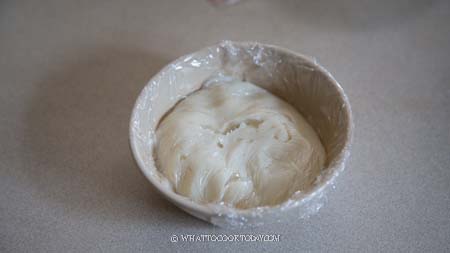
2. Place the flour, instant yeast, sugar, salt, baking powder, oil in a mixing bowl of a stand mixer and stir to combine. Add tangzhong paste or yudane to the dough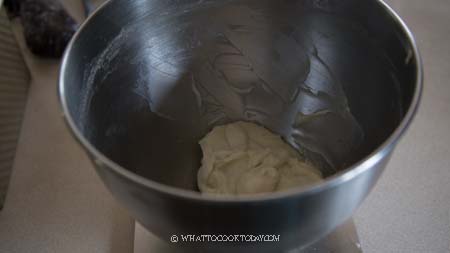
3. Attach the dough hook to the stand mixer. Turn on the mixer at the lowest speed to prevent the flour from flying all over the place. Knead at low speed (speed 2 on KA) for 3-4 minutes or until the dough roughly come together. If the dough feels dry, add milk, one teaspoon at a time. The dough needs to feel soft. You can increase the speed to speed 4 and knead until the dough clears the side of the bowl, and feel smooth and soft, about 3-4 minutes (depending on your machine too).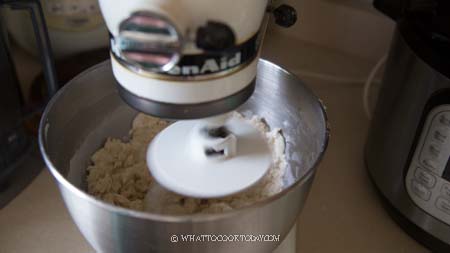
4. If the dough feels stiff, don’t be afraid to add more milk. Soft dough is one of the keys to getting soft and fluffy steamed buns. You don’t need to develop a window pane here but the dough needs to be soft and smooth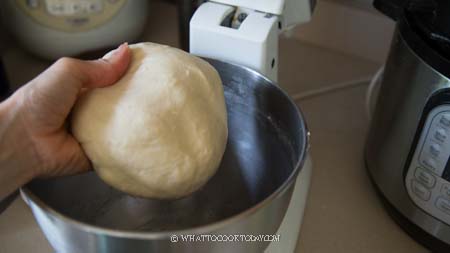
5. Divide the dough into 8-10 equal portions. To make plain buns without filling, flatten and gather the edge to round them up into dough balls. Roll the dough into a smooth round ball in between the palm of your hand or as I did in the video. REALLY make sure the dough is smooth.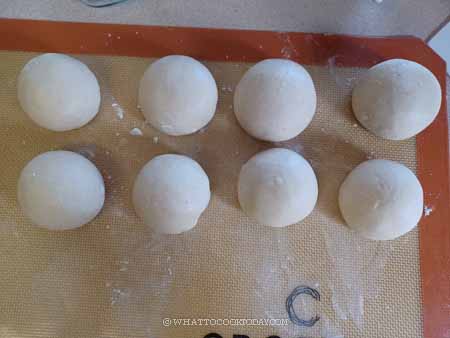
6. If you want to add a filling, flatten the dough with your palm and then use a rolling pin to roll it out to form a circle about 4-5 inches, with a slightly thicker middle part. This is to support the weight of the filling. Don’t roll the dough too thin. If you roll the dough too thin, the filling might make the steamed buns “wrinkle” later when you steam. Place the filling at the center and then gather the sides to enclose the bun and pinch to seal. Flip the bun so the seam side is down now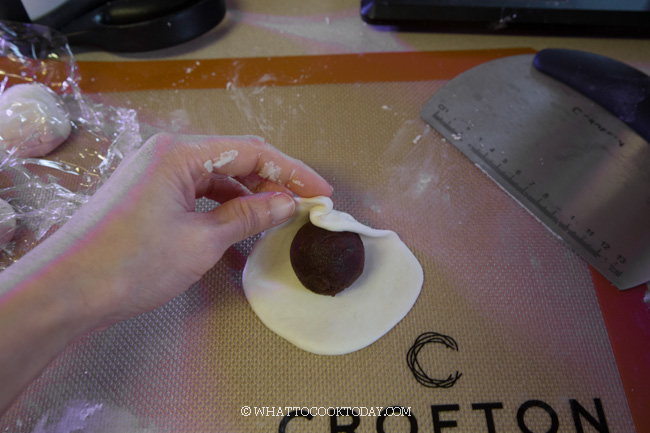
7. Place on a piece of parchment paper. Lightly dab the surface of the bun with some milk using your finger to smooth the surface. You can also mist with some water using a spray bottle. Loosely cover with clean kitchen towel to prevent drying. Work with another dough and do the same. Proceed to proofing after that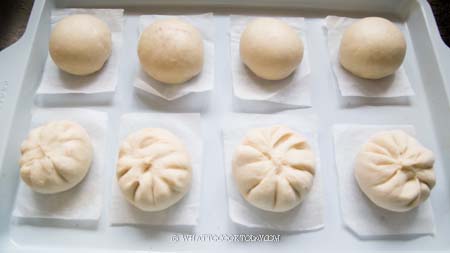
8. Let the dough rise at room temperature or at a warm place. If it’s winter where you are, you can use your oven “bread proof” function to let them proof in there, or simply turn on your oven to the lowest temperature and then turn off and after 15 minutes, place the shaped buns in there to let them proof. They won’t necessarily double in size, but at least puff up to about 50% of the original size. This may take about 1 hour or longer at a warm temperature. Don’t go by the time however. Observe the dough instead! Use a finger test too. When you gently push on the dough, it will leave an indentation but it will spring back slowly. This dough is perfectly proofed.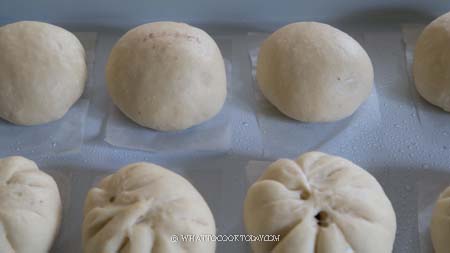
9. Fill up the steamer with water but do not turn on the stove yet. Carefully arrange the proofed buns in the steamer, giving about 2 inches of space in between as they will expand quite a bit. Cover with a lid wrapped with a cloth to prevent condensation from dropping on the surface of the buns. If you use a bamboo steamer, you don’t need to wrap the lid as bamboo steamer absorbs liquid
10. When the water comes to a simmer, crack the lid open about 1/2 inch gap and start the timer. Steam with the lid cracked open like that for 15 minutes for large buns, about 10 minutes for medium buns
11. After steaming, turn off the heat. DO NOT OPEN THE LID of the steamer. Let the buns sit there for 3 minutes. The buns will not sink or wrinkle due to the sudden change in temperature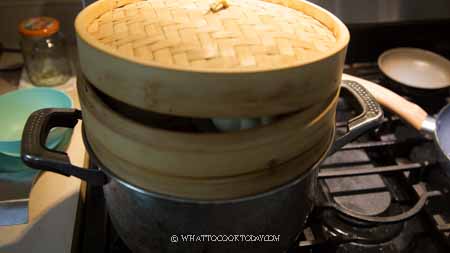
12. Serve them warm or immediately remove the buns to a wire rack to let them cool down. This is to ensure the bottom of the steamed buns will not be wet and soggy
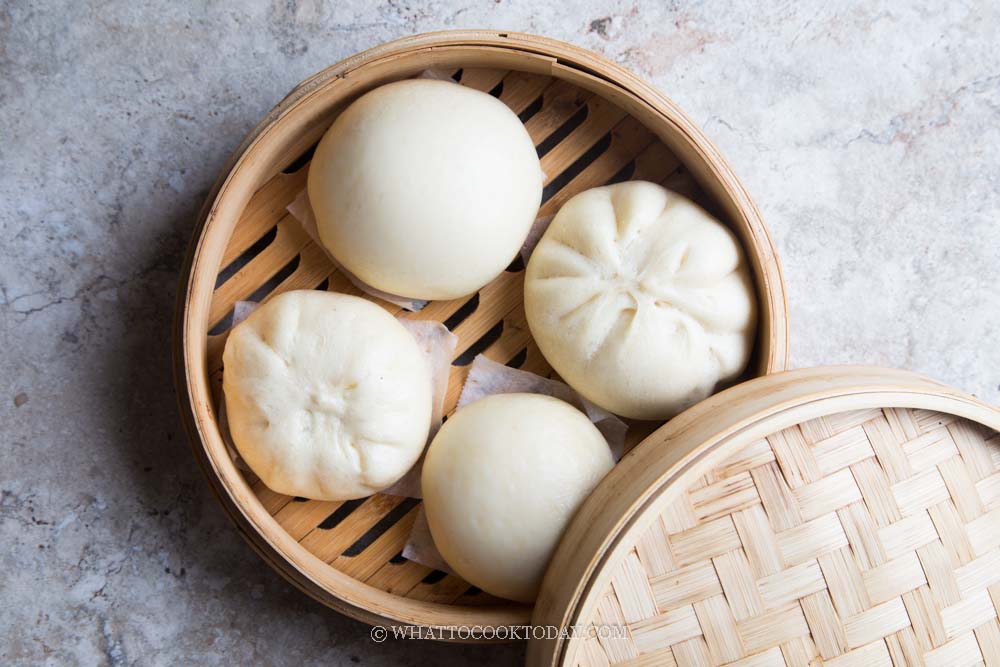
Variations
The steamed buns can be made plain or can be stuffed with the sweet or savory filling of your choice. For more inspiration, you can check out my steamed buns archive.
Did you make these steamed buns with tangzhong or yudane ?
I love it when you guys snap a photo and tag it to show me what you’ve made. Simply tag me @WhatToCookToday #WhatToCookToday on Instagram and I’ll be sure to stop by and take a peek for real!



13 comments
can these be proofed overnight?
Hi SG, I haven’t tried it, but I don’t see why not! After you are done kneading the dough, shaping, etc, you can cover them with lightly oiled cling wrap (to prevent sticking and dough from drying out in the fridge) and let the buns proof overnight in the fridge. Get them out from the fridge 30 minutes or so before you plan to steam so that they have a chance to come to a room temperature before steaming. I hope it works out great and let me know how they turn out when you have the chance to do so 🙂
Yes, they turned out great! following your method was such a time-saver. Just imagine freshly steamed bao for breakfast in just under an hour😃amazing!
Yes!! I’m happy to know that! freshly steamed buns for breakfast sound like a great plan to me!!!!